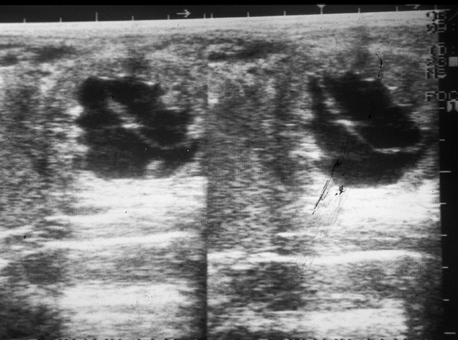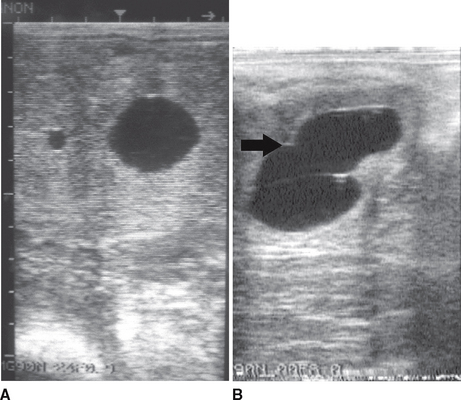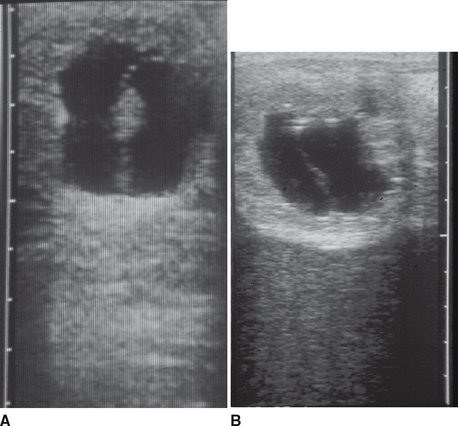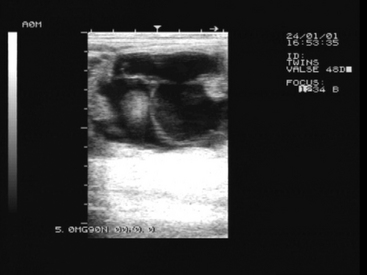CHAPTER 54Twin Reduction Techniques
We have known three things about twins for a long time. First, twins are repeatable within the same mare. Second, the twinning rate varies according to breed. Third, the more fertile the stallion, the more twins he is expected to achieve.
Historically twins have been the single most important cause of abortion in Thoroughbreds.1,2 Because most twin pregnancies terminate in early fetal resorption or loss, late term abortions, or the birth of small growth retarded foals, and because mares aborting twins in late gestation frequently have foaling difficulties, damage their reproductive tracts, and are difficult to rebreed, twins are disastrous financially. If foals are born alive they are frequently small, have intra-uterine growth retardation, and a poor survival rate, with many needing expensive, sophisticated, critical care.
Origin, associations, and a general overview of twinning in the horse have been published elsewhere.3,4
The incidence of abortion has been reported as decreasing,5 and in the German Thoroughbred industry it has almost halved since the advent of ultrasonography.6
ORIGIN OF TWINS
Twins in the horse are unlikely to be identical. Almost all cases of twin pregnancy are expected to be related to multiple ovulation, although at least two occurrences of monozygotic twin pregnancies have been suspected.7,8 The reason for lack of identical twin formation in the horse is probably related to the capsule.9 The capsule forms in equine embryos aged around 6 days, shortly after their entry into the uterus.10,11 When embryos were cultured before the formation of the capsule, hatching occurred in a manner similar to that which occurs in the bovine11; however, when embryos were cultured after formation of the capsule, the zona pellucida continued to become progressively thinner and finally fell away from the developing conceptus. Other species that do not have a capsule, such as sheep, cattle, and humans, all have the ability to routinely give birth to identical twins, which apparently form from pinching of a hatching embryo by the zona pellucida.
It has been shown that twins in mares are as likely to result from synchronous versus asynchronous ovulation12 and that pregnancy rate per follicle was identical for double ovulations on opposite ovaries to that obtained from single ovulations per cycle, but was higher than the pregnancy rate per follicle when double ovulations occurred on the same ovary.13
WHAT HAPPENS IF WE DO NOTHING?
The mare is very efficient at reducing twins to a single pregnancy. This is done by a competitive absorption of nutrients that is related to size and position of the early pregnancy and later to orientation of the embryo proper within the developing conceptus.14 However, the initiation of any nonintervention program depends on the age of identification, the orientation of the vesicles, and any disparity in size.
Recognition = 16 Days from Ovulation
Embryo reduction before or on the day of fixation is not considered an important aspect of the natural correction of twins.15 The probability of a mare losing one or both vesicles of a set of twins from identification before fixation is minimal and approximates that of early embryonic death for the same time period (per vesicle). The recognition of twin pregnancies before fixation day (day 16) is dependent on the day of examination relative to the day of ovulation. Asynchronous ovulations occasionally result in a gross disparity in vesicle size, sometimes as much as 4 to 5 days (i.e., identification of a day 11-12 and a day 16 vesicle concurrently) (Figure 54-1, A). In instances such as this, examination one day earlier may have failed to detect the younger of the 2 pregnancies. Recognition that all twin pregnancies occur from multiple ovulations dictates mandatory reexamination of all mares that have 2 corpora lutea (CL) and only a single vesicle detected before fixation (day 16). Recognition before fixation is also dependent on operator experience, resolution of the equipment (= 5 MHZ preferred), monitor capabilities, restraint, other facilities (ability to darken the environment), the presence of uterine cysts, and the skill of the examiner.
Recognition after Fixation (after Day 16)
The recognition of unilaterally fixed twins from day 17 through to 21 (before clear recognition of the developing fetus within the vesicle) may be the most difficult time to determine whether there are twins present. Ultrasonicgraphically, all that is detectable is a thin line (the apposition of the 2 yolk sacks) running approximately in the middle of a slightly over-sized vesicle (Figure 54-1, B). Recognition of the fetus(es) within the vesicle a few days later makes differentiation easier (Figure 54-2). Occasionally an inexperienced operator may confuse an abnormally orientated 28 to 30 day single pregnancy with 17 to 20 day unilaterally fixed twins (Figure 54-3). From days 22 to 60 the presence of multiple fetuses, umbilical cords, and general excess in the number of visible membranes should alert the practitioner to the likelihood of more than 1 pregnancy (Figure 54-4). The junction between 2 developing fetuses (after 30 days) between the 2 allantochorions results in a common membrane from the area of apposition. This common membrane has been referred to as the twin membrane (see Figure 54-4)16 and has diagnostic potential, particularly late in pregnancy when it might not be possible to view both fetuses transrectally (>100 days). After 100 days, careful transabdominal ultrasonography may be necessary to determine the presence of twins.

Figure 54-2 Recognition of a fetus in each vesicle at or around day 20 to 22 helps identification of some twins.
Days 17 to 40
The outcome of pregnancies post fixation is dependent upon their size (diameter) and the nature of their fixation. Unilateral (both fixed together at the same corpus cornual junction) fixation reduction is much higher than bilateral (one on each side) fixation reduction. Fortunately, unilateral fixation is much higher (approximately 70%) compared to bilateral (30%).14 In 28 mares with known ovulatory patterns, synchronous ovulations did not affect the type of fixation (9/17 unilateral, 8/17 bilateral). However, for asynchronous ovulation, the frequency of unilateral fixation (10/11) was greater (P < 0.01) than the frequency of bilateral fixation (1/11). The incidence of embryo reduction was greater (P < 0.01) for unilateral fixation (14/19) than for bilateral fixation (0/9) and was greater (P < 0.05) for asynchronous ovulation (9/11) than for synchronous ovulation (5/17).14 Practically speaking this means that if asynchronous ovulations have resulted in significant age differences between vesicles (i.e., >3 mm diameter at day 15), then rate of embryonic reduction is very high.14 In cases of unilateral fixation, 22 of 22 mares with vesicles of dissimilar size had reduction compared to 19 of 26 (73%) with vesicles of similar size.17 As a result of work studying reduction of unilateral versus bilateral twin pregnancies in mares from days 17 to 40, Ginther proposed that the nutrient intake from the larger vesicle (before the fetus was present) prevented adequate nutrition of the smaller vesicle. Later the position of the fetus proper and its emerging allantoic sac seemed to determine whether a given conceptus survived or underwent late reduction. The fetus, the vascularized wall of the yolk sac adjacent to the fetus, and the emerging allantoic sac were exposed to the endometrium (uterine lumen) in the surviving vesicles. In the vesicles that underwent reduction, much of the corresponding area of the vesicle wall was covered by the wall of the adjacent survivor and was thus deprived of adequate embryonal-maternal exchange and therefore regressed.
In summary, dissimilarity in diameter increases the likelihood of unilateral fixation, increases the incidence of reduction for unilateral fixed vesicles, hastens the day of occurrence of reduction and shortens the interval from initiation to completion of reduction.14
Of the 85% of reductions by day 40 in cases of unilateral fixed twin pregnancies, 59% of reductions occurred between days 17 and 20, 27% between days 21 and 30, and 14% between days 31 and 38. The majority of early reductions occurred spontaneously, by day 20, compared to reductions after day 20, which were preceded by a gradual decrease in size of the eliminated vesicle. In addition, when twins were dissimilar in diameter (4 mm or more), they were more likely to undergo reduction by day 20.17 Other studies have demonstrated similar results. The hypothesis of an early embryonic reduction mechanism for elimination of excess embryo in mares is not new and was suggested as early as 1982. However, ultrasonography was necessary to adequately document the occurrence and nature of the reduction.18
Day 40 Onward
Ginther and Griffin16 examined the natural outcome of bilateral twins (one in each horn) that were viable on day 40 in 15 pony mares. Readers should be aware that pony mares are not necessarily a good model for larger breeds, as the incidence of twins is low and evidence suggests that the larger the breed (Draught, Thoroughbred and Warmblood), the higher the probability of maintaining twins. Fifteen pony mares were monitored by ultrasonography until the outcome of the pregnancy was determined. Sixty-six percent (10/15) of the pregnancies resulted in either death of both (80%) or death of one (20%) during months 2 or 3. Nothing occurred from then until month 8. Between months 8 and 11, 2 mares lost 1 fetus (fetal death was associated with mummification) and 2 mares lost both. The 2 mares that lost 1 pregnancy both delivered undersized, weak foals at birth. One mare (7%) delivered live twins at term, and 2 normal foals were born from mares losing the 1 pregnancy (absorption of the fetus rather than mummification) in month 2. In this study, 6 live foals were born (2 of normal size) from a total of 15 mares and 30 fetuses. This incidence is similar to a previous report wherein, of 130 pregnant mares with twins, only 17 live foals (13%) were produced.19 An interesting observation from the latter report was that from the 102 mares that delivered live or dead twins in the previous year, only 37 produced live foals the next seasons, and thus over 2 seasons there was an average of 23% producing live foals.19 An earlier study20 was extremely useful in categorizing outcome of twins that managed to survive to later pregnancy. Twinning accounted for 22% of the cases of abortion and stillbirth between 1967 and 1970. Sixty-two sets of twins and their placentas were examined from Thoroughbred mares. All were considered to be dizygous. Abortion or stillbirth of both twins from 3 months of gestation to term occurred in 64.5% of mares, although most (72.6%) slipped from 8 months to term. In the remaining cases 1 twin (21%) or both twins (14.5%) were born alive. Most foals at term were stunted and emaciated, and of the 31 alive at birth, only 18 survived to 2 weeks of age.20 In this study, twin placentation was divided into 3 morphological groups according to the disposition of the chorionic sacks within the uterus. Type A placentation was seen in 79% of cases (48 sets of twins). One fetus occupied 1 horn and most of the body (mean 68% of the total functional surface area), while the other twin occupied only 1 horn and usually only a small part of the adjacent body. Where the chorions abutted there was a variable degree of invagination of the smaller chorion into the allantoic cavity of the larger twin. These pregnancies frequently ended in abortion or stillbirth of 1 or both twins. In this group, 31 of 48 mares lost their pregnancies between 3 and 9 months (64.5%). The gestation length in this group was frequently shorter, and at birth the larger twin had a much greater chance of survival than the smaller one. In this group, only 6 foals of 48 sets were born alive. Of the 6 fetuses born alive, 5 were the larger twin. Type B placentation occurred in 11% of cases (7 sets), and the placentas were orientated such that the villous surface areas were more or less equally divided and each fetus occupied 1 horn and half of the body. Both foals were usually similar in size and were usually born alive. Nine foals survived to 2 weeks from 6 sets of twins that made it to term. In this group (7 total), 1 was aborted at 7 months. Type C placentation was seen in 10% of cases (6 sets of twins). In this group there was a greater disparity between the surface area of the 2 chorions. The smaller twin occupying only part of one horn died earlier on and became mummified. The larger twin was usually born alive and had a fair chance of survival. In this group, 3 foals were born alive from 6 pregnancies at term.21 The authors attributed the loss of twin fetuses and poor survival rates to placental insufficiency.






